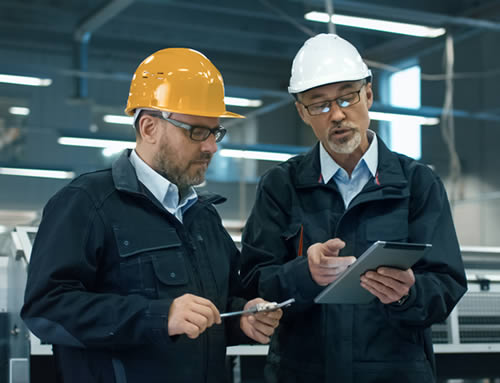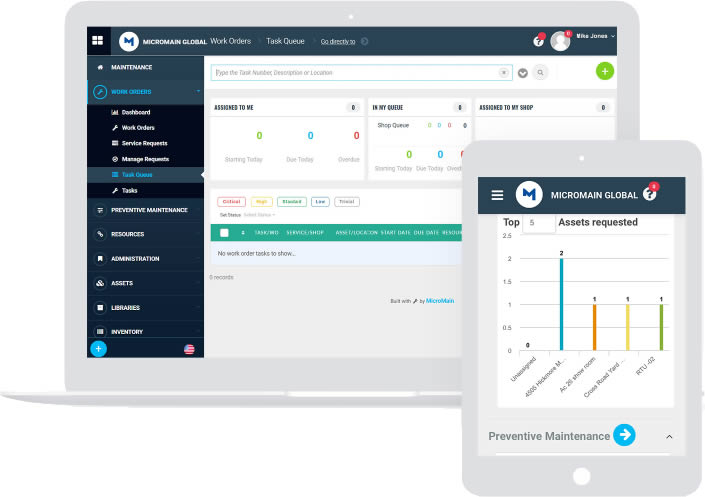Asset Repair or Replace?
An important asset has broken down. What now? When equipment breaks down, everything from your productivity to your bottom line is disrupted. Your team needs a quick and effective solution. The difficult question arises- should you try for a repair, or replace the asset outright?
Replacing equipment is the larger investment, so many technicians choose to repair the equipment instead of replacing it. But the costs that go along with frequent breakdowns — lower productivity, defective output, rising labor costs, and unmet production schedules — can sometimes be greater than the cost of replacing the equipment outright.
Leaving your decisions to guesswork can be a costly and dangerous approach. If you aren’t using a computerized maintenance management system (CMMS) effectively, you’ll be forced to make decisions reactively, and as soon as something breaks down, you’ll need to make a quick decision on what to do. With productivity plummeting, your decision will likely be made from an emotional standpoint, rather than solid data to support your decision.
Data Driven Decisions
Without a plan in place, your only concern will be getting your production back online as quickly as possible. The reactive decision you’re forced to make may work out, but you may also end up making a hasty decision that solves the problem in the short-term but isn’t the best solution in the long run.
In addition to the obvious replacement cost for a new piece of equipment, there are several other factors to take into consideration when deciding whether to repair or replace a piece of equipment:
- Ongoing maintenance costs over the remaining life of the equipment
- The impact any repair would have on productivity and quality
- Costs incurred from the equipment downtime
- Health, safety, and environmental costs that come with equipment breakdown
- Training costs for a new piece of equipment
- Disposal costs
- Installation costs


With so many factors to consider, it’s clear this decision shouldn’t be made without the proper data analysis.
Analyze the Costs
Always think in the long-term when analyzing the costs of repairing or replacing. For a new piece of equipment, consider the cost of purchasing the equipment, its service life, potential salvage value, operating costs, and any revenue increase it may bring.
For an old piece of equipment, consider its remaining service life, operating costs, its market value and future salvage rate. From these figures, you can determine an annual average cost for each option, which will then be easy to compare.
Consider the Age of Equipment
Equipment does not age with grace. The older your machinery, the more extensive repairs it will need. This often translates to higher maintenance costs. As you continue to repair, the machine will give you less and less for your investment of repair. You may want to consider replacing an old malfunctioning piece of equipment for a newer, technologically advanced model that will give you better efficiency and longevity. When your equipment is new, it makes more sense, in many cases, to repair it once it malfunctions.
Consider the Cost of Repairs
What are the cost of repairs, and more importantly, how often will you be paying those costs for repairs? Documenting asset repair events provides information on number and frequency of breakdown events and costs for the repairs. Can you tell if you’re going to continue repairing this equipment several times a year, or will it likely just be a one-time fix?
Consider Downtime
What’s the impact of downtime while the asset is being repaired? If it takes several days to repair, and if this happens frequently, you’re looking at too many hours of lost productivity. Consider this when deciding if repair or replacement is better in your situation.
Keep in mind, however, that repairing often takes less time than replacing a machine. Replacing involves waiting for the replacement to arrive, installation, new training, and more. If you’re on an extremely tight schedule and if the equipment is crucial to your process, you may lose too much in production if you take the time to replace.
Consider Safety
Remember that older equipment can cause injury to workers if it malfunctions. Even if you stay up to date on maintenance, equipment wears down as it ages. Thoroughly inspect your machinery before making your decision so you can determine if your current equipment will continue to provide a safe environment for your workers. If it won’t, replacement is the obvious choice. If it is still meeting safety standards, it’s worth comparing costs of a replacement versus repair.
Consider Efficiency
Always think of the long run. How efficient is your machine operating now, and will a simple repair keep efficiency at the level you want, or would a new piece of equipment that uses less fuel, offers newer features, and breaks down less frequently be better for your efficiency and your bottom line?
Maintenance Management Software

MicroMain’s Computerized Maintenance Management System (CMMS) enables businesses to make more informed decisions when it comes to repairing or replacing equipment. Decisions will be based on actual data provided by the CMMS / EAM solution, not merely guesses. MicroMain’s CMMS / EAM solutions help businesses streamline their maintenance operations and take the guesswork out of their maintenance related decisions.
